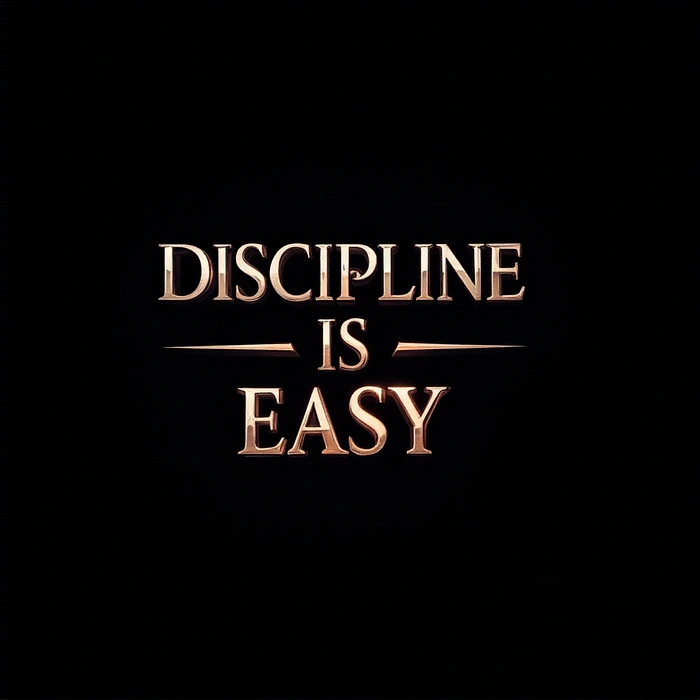Here's How You Can Build Discipline in 4 Easy Steps
Reprogram your life to build discipline with these 4 simple steps.
Mar 3, 2025 | 7 min read
Your current behaviours are a sum of habits built overtime. You can change them, if you want to.

Let’s kick things off with a short story of an average Joe.
Joe enrolled for an online course and set himself to finish it within a certain deadline. That day came but Joe was nowhere near completion.
Does this sound familiar?
Few weeks ago, I was Joe. In fact, for years, I have been Joe. I was unable to get past my distractions and achieve the goals I had set for myself.
But then I found a mental model that helped guide me into doing “hard” things and achieving more.
You might be Joe right now, but that’s okay. That’s all about to change. I’ll guide you, step by step, through the simple framework that helped shift my mental orientation and build discipline.
Why is it so hard to be disciplined?
Before we get into the framework, we need to understand why discipline is so hard in the first place. Why are some things easy to do and some are not?
To understand this dilemma, we will observe a neurological concept known as The Primal brain.
So a bit of a backstory.
The primal brain is the oldest and deepest part of the brain that retains our primal instincts. It has the same basic commands as the ancient times.
Despite the evolution of science over the years, our brains haven’t changed so much from what it was 60,000 years ago.
In the age of early men, survival was uncertain and because of that humans prioritized instant gratification. Get food, eat food. We lived without a concept of restraint or bigger picture.
As humans evolved, new concepts like long-term plans and future goals came into the scene. And so, we decided to sacrifice, work hard and build discipline in order to achieve our future goals.
However while our neurology has evolved over millennia, we still retain the primal parts of our brain. The parts that prioritizes gratification and continued existence.
We are still hard wired to choose instant gratification.
This is why Netflix almost always wins against the book you want to read. It is also the reason why junk food seems more appealing than your workout meal plan.
You make these choices based on instinctual programming.
Left unchecked the primal brain influences bad decisions by prioritizing immediate gratification over logical reasoning.
But we cannot blame the brain for not achieving our goals. How do you intend to punish your brain? What we can do instead, is to shift this mental programming to our favour.
The underlying principle of this framework uses the neurology of the primal brain to make hard things easy and fun. This way, exercising discipline is not difficult, it comes naturally.
The step by step guide to reprogram your life for discipline
We have seen the background story of the primal brain and why we tend to choose gratification over discipline. Now we will discuss the 4 step framework to build Discipline.
The 4 steps are:
1. Make it clear
2. Make it simple
3. Make it familiar
4. Make it rewarding
Let’s begin with the first step
Step 1. Make it clear

Defining what you want to do it the first step.
There are 2 parts to making it clear.
a). Identify what you consider as hard and difficult.
In this time and age where everything is striving for your attention, it becomes increasingly important to make your priorities clear.
It’s impossible to act when you don’t know what to act on.
The first step to building discipline is to identify what you want you want to be disciplined in.
b). Set your environment up for success
To make an action clear, it is important to use the principle of environmental design.
In his book Atomic Habit, James Clear talked about how you can design your environment for success.
After Identifying the task you want to accomplish, create an environment that makes this task very obvious.
Here is a practical instance.
Justin is a 25 year old social media manager. He wants to build the habit of reading but he struggles to find time due to his social media engagement. He often procrastinates and ends up not reading at all.
Here is how Justin can use the 1st step of the framework.
Identify the task: Read books more
Design your environment: Each night before bed
Set a chair by the bedside. On the chair is the book I want to read, a notebook and a pen.
Put my phone on “DND” and place it in the farthest end of the room.
First, Justin brought the task to the fore of his thoughts. And then, he designed his environment so that when he wakes up, the first thing he sees is the task at hand: Read a book.
So, step one to building discipline is to make the task clear.
Step 2. Make it simple

Let’s do a pragmatic analysis.
Which of these is easier to do: A 10 minute home workout or an hour at the gym?
Which of them can you repeat everyday?
Unless you’re a bodybuilder (or Arnold Schwarzenegger), an hour everyday at the gym is unlikely.
If you want to build discipline, then you need to make the hard things simple to do. Make it so simple that you can repeat it with little to no mental friction.
The goal here is not to overload, but to compound.
When you simplify a task you want to achieve into bit-sizes, it becomes easy to complete.
These small bites of progress reinforces a better identity. You no longer see yourself as someone who does not finish their courses on time. You begin to see yourself as someone who reads everyday, a lifelong learner.
Practical example with Justin, the social media manager who wants to read more.
Here is how Justin can apply the 2nd step.
Make it simple: Read 3 pages of the book.
3 pages of a book is only about a few minutes. Depending on the focus level of the individual. But don’t forget, Justin already designed his environment to reduce distractions.
So the 2nd step to building discipline is to break the task into simple, repeatable steps.
Step 3. Make it familiar

The habits you have right now exist because you are used to them. You default to doing the things you are familiar with.
So it goes without saying that you struggle to build discipline because you are not familiar with the task.
The primal brain does not just choose gratification. It chooses gratification over what it perceives as difficult. So to gain back control, you need to make your goal not so difficult.
Let’s consider the example of Justin.
In step 1, he clarified the task he wants to achieve.
In step 2, he simplified the task to small actions.
Step 3 for Justin would be to repeat these small actions.
Actions repeated accumulate over time. You’d be surprised how far you can go by compounding small steps.
Step 4. Make it rewarding

The reason why you do not take action is because you do not think the action will benefit right now.
There’s no benefit to be had today so why do it today?
But what if there is?
What if after a 10 minute intense workout, you reward yourself with a cold glass of smoothie? It’s pretty simple but that one tweak can change things.
Overtime, you will start to associate working out with a cold glass of smoothie. Soon, you start to look beyond the pain of working out because there is an assured gratification (the smoothie) that follows after.
This was the exact same technique I used on myself during my early days of running.
I would go out for an evening run and mentally, I would tell myself:
“After this run, I’m going to make an avocado and banana smoothie.”
And after my run, I did as I promised myself.
Thanks to this little change, the frequency of my evening run increased, as did the intensity and duration.
I share more about my personal lessons and insights in my newsletter, Atypical Mindset.
To stay consistent with the example of Justin
For Justin, the 4th step could go like this:
Make it rewarding: After reading 3 pages of a book, drink a glass of water.
It doesn’t have to be something grand. It’s all up to you.
When we can associate a pleasurable experience with a difficult task, the task becomes less difficult. In most cases, you start to enjoy it and even anticipate repeating it.
To recap
The reason you are not so disciplined is because you keep choosing gratification over rationality. But this is due to a primal conditioning of the brain.
You can reprogram your life and build discipline using 4 step framework
Step 1. Make it Clear — Identify your priorities and design your environment for success
Step 2. Make it Simple — Break tasks into bite-sized, repeatable actions
Step 3. Make it Familiar — Build consistency through repetition
Step 4. Make it Rewarding — Create immediate positive associations with challenging tasks
In sum, discipline is like a muscle; it can be built. You do not need extraordinary willpower. With these simple actions, you can reprogram your life to build discipline.
Remember, actions repeated accumulated over time.
I talk more about the law of accumulation and how to make it work for you in my newsletter.
I look forward to what great things you will do.
Like this project
Posted May 29, 2025
Published an article on building discipline using a 4-step framework.
Likes
0
Views
0
Timeline
Mar 3, 2025 - Mar 3, 2025





